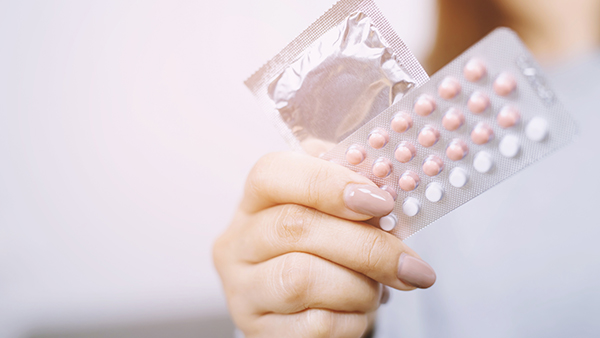Contraception containing hormones
There are hormonal contraceptive methods which contain either two hormones: oestrogen and progestogen; or only one: progestogen. Contraception that uses hormones works by preventing ovulation and making the cervical mucus too difficult for the sperm to get through. Here you can read more about different contraceptives that use hormones.
Read time: 6 m
Verified by Jenny Jansson
Certified midwife
Etonogestrel contraceptive implant
This is an implant in the form of a small silicone rod that releases a hormone called etonogestrel into the body. The hormone inhibits ovulation and makes the cervical mucus thicker and sperm less mobile. The contraceptive implant is inserted and removed by a midwife or gynaecologist. If you wish to regain fertility, the implant can be removed and its effect quickly disappears. The contraceptive implant stays in place for up to three years and can be removed at any time. It can even be used if you are breastfeeding, six weeks after birth.
+Advantages
This means you can have sex without worrying about getting pregnant. For women who experience side effects from oestrogen, the birth control implant can be an option. Some women experience reduced bleeding and less menstrual pain.
− Disadvantages
The contraceptive implant does not protect against HIV/Aids or venereal diseases. Some women gain weight and may feel breast or stomach pain.
Contraceptive Injections
This form of birth control involves a progestogen injection that inhibits ovulation and makes the cervical mucus thick so that sperm are less mobile. The injection is administered by a midwife or gynaecologist. The effects from one injection last for three months, and can't be cancelled out once you have received the injection. You must get your next injection at the right time for it to continue to be effective.
+Advantages
This means you can have sex without worrying about getting pregnant. For some women, it can result in shorter and lighter periods, or make their periods disappear completely.
− Disadvantages
Contraceptive injection does not protect against HIV/Aids or venereal diseases. Some women experience headaches, mood swings, itching, and redness on the skin where the syringe is given. The birth control injection can also cause irregular bleeding. It can take up to a year to regain fertility.
IUS
A small, soft, T-shaped insert with a capsule that releases progestogen. It is inserted and removed by a midwife or gynaecologist. Fertility returns to normal when the IUS is removed. It can be used even if you are breastfeeding. The IUS can stay in place for up to five years and can be removed at any time.
+Advantages
99.8% effective. The IUS means you can have sex without worrying about getting pregnant. For women who experience side effects from oestrogen, the hormonal IUS may be an alternative as it only releases a progestogenic hormone into the uterus. This hormone acts mostly locally. Some women experience shorter periods with lighter, or less frequent, bleeding.
− Disadvantages
The hormonal IUS does not protect against HIV/Aids or venereal diseases. Some women experience headaches, soreness and acne after insertion. Some women also experience irregular bleeding, menstrual pain and spotting during the first six months.
Birth control pills
The pill is a hormone tablet taken once a day, at the same time every day. Birth control pills alter your natural hormonal cycle and are available both as combined birth control pills and progestogen-only pills. Combined oral contraceptives contain oestrogen and progestogen, which inhibit ovulation. Progestogen-only pills contain only progestogens. Birth control pills should not be used in the first six weeks after giving birth due to the increased risk of blood clots after childbirth.
+Advantages
This means you can have sex without worrying about getting pregnant. Most women who use the pill have more regular periods with lighter, and less painful, bleeding. Pills that contain only one hormone, progestogen, can be a suitable option for people who have experienced negative side effects from oestrogen.
− Disadvantages
Birth control pills do not protect against HIV/Aids or venereal diseases. Some women may feel nauseous, have sore breasts, or have headaches.
Vaginal ring
The contraceptive ring is made of soft, flexible plastic and releases progestogen and oestrogen in low doses, which then travel gradually throughout the body. The contraceptive ring must be in place in the vagina for three weeks. You take it out yourself in the fourth week and then insert a new one, to begin a new four-week cycle. The contraceptive ring should not be used in the first six weeks after giving birth because of the increased risk of blood clots after childbirth.
+Advantages
This means you can have sex without worrying about getting pregnant. If the birth control ring is used in exactly the right way, there is only a one per cent risk of pregnancy. For some women, their period disappears completely when using the birth control ring.
− Disadvantages
The contraceptive ring does not protect against HIV/Aids or venereal diseases. It is crucial to keep track of the number of weeks you have been using it. Some women experience vaginal discharge, discomfort, headaches, mood swings, weight gain, and irregular periods.
Patches
The contraceptive patch continuously releases oestrogen and progestogen, which then travels throughout the body. The patch must be changed once a week to be completely effective. The progestogen and oestrogen enter the bloodstream through the skin. These hormones inhibit ovulation and make the cervical mucus thicker, so that sperm are less mobile. The patch should be in place for a week and then be replaced with a new one. Birth control patches should not be used in the first six weeks after giving birth because of the increased risk of blood clots after childbirth.
+Advantages
It's easy to use because you are in control of it yourself. The patch makes it easy to have sex without worrying about getting pregnant. For some women, using contraceptive patches results in more regular periods and lighter bleeding.
− Disadvantages
Birth control patches do not protect against HIV/Aids or venereal diseases. The patch is visible. It may be at risk of coming loose, which then affects its effectiveness. Some women experience headaches, mood swings, itching, and redness in the area around the contraceptive patch. The contraceptive patch can also cause irregular menstrual bleeding.
Verified by Jenny Jansson
Certified midwife
More from Preggers
Hundreds of related articles, podcasts & more waiting for you in the Preggers app.
Download Preggers today.

